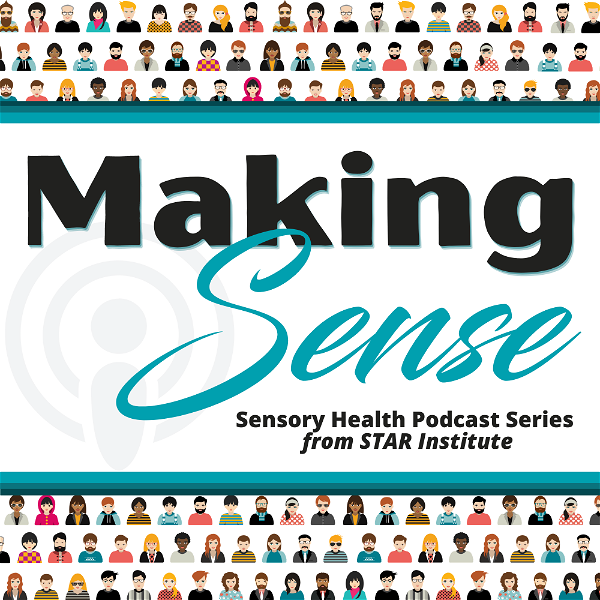
Making Sense
STAR InstituteOccupational therapy best practices ask us to integrate knowledge into practice. Each episode offers a conversation aimed at translating the most current research into clinical action for occupational therapy practitioners. Produced by the STAR Institute, a 501(c)3 nonprofit organization, in an effort to further our commitment to impacting the quality of life.
| Publishes | Twice monthly | Episodes | 18 | Founded | 5 years ago |
|---|---|---|---|---|---|
| Categories | BusinessEducationNon-Profit | ||||
Listen to this Podcast

Latest Episodes
Anita Bundy, ScD, OT/L, FAOTA, FOTARA is a professor and head of the occupational therapy department at Colorado State University. She has conducted decades of experiments and research in Risky Play. Listen as Dr. Bundy shares both the benefits of ri... more
Family Nurse Practitioner and Parent, Holly Healy offers both personal and professional insights into sensory differences. She recognizes the way that traits of ADHD and SPD present similarly and offers insight into her process as a parent of a child... more
Join Dr. Lori Desautels to explore how trauma and adversity impact the developing brain and body and show up in the challenging behaviors we sometimes see. Learn about mitigating the effects of trauma in our schools and communities while building res... more
Parents of two boys with sensory differences discuss the experience of diagnosis and their pathway to building a sensory lifestyle for their family.
Episode Guests: Jerade and Maria Tipton
The views expressed in the following presentation are those... more
According to the Administration for Children and Families (n.d.), nearly 500,000 children and youth are currently in the foster care system in the United States. Caregivers and professionals who work with children in the foster care system must have ... more
Making Sense Season 3 is Sponsored by Our Community Partner Summit Sensory Gym
Are you an occupational or physical therapist struggling to excite your patients with different therapeutic activities, or even worse are finding that your therapists and... more
The concept of neurodiversity is credited to a sociologist named Judy Singer. Neurodiversity recognizes and pays respect to the diversity of human minds, and the infinite variation in neurocognitive functioning within our species (Walker, 2014). Toda... more
Evidence-based practice is vital to focus the OT lens and voice in the autism community. Occupational therapists are in a position to recognize the importance of the occupation of caregiver and provide evidence-based support in intervention when wor... more
Key Facts
Reviews
- Another podcast trying…
Another podcast trying to piggyback on the success of the more popular “Making Sense” podcast.
- Wonderful resource for all things SPD
I’ve only just begun listening to this podcast but I’ve already learned so much. It is not lost on me how lucky I am to be able to access all of this info for free on a podcast. Thank you!
Chart Rankings
How this podcast ranks in the Apple Podcasts, Spotify and YouTube charts.
Apple Podcasts | #229 |
Top Non-Profit Podcasts










Audience Metrics
Listeners, social reach, demographics and more for this podcast.
| Gender Skew | Location | Interests | |||
|---|---|---|---|---|---|
| Professions | Age Range | Household Income | |||
| Social Media Reach | |||||
Frequently Asked Questions About Making Sense
Where can I find podcast stats for Making Sense?
Rephonic provides a wide range of podcast stats for Making Sense. We scanned the web and collated all of the information that we could find in our comprehensive podcast database. See how many people listen to Making Sense and access YouTube viewership numbers, download stats, audience demographics, chart rankings, ratings, reviews and more.
How many listeners does Making Sense get?
Rephonic provides a full set of podcast information for three million podcasts, including the number of listeners. View further listenership figures for Making Sense, including podcast download numbers and subscriber numbers, so you can make better decisions about which podcasts to sponsor or be a guest on. You will need to upgrade your account to access this premium data.
What are the audience demographics for Making Sense?
Rephonic provides comprehensive predictive audience data for Making Sense, including gender skew, age, country, political leaning, income, professions, education level, and interests. You can access these listener demographics by upgrading your account.
How many subscribers and views does Making Sense have?
To see how many followers or subscribers Making Sense has on Spotify and other platforms such as Castbox and Podcast Addict, simply upgrade your account. You'll also find viewership figures for their YouTube channel if they have one.
How many episodes of Making Sense are there?
Making Sense launched 5 years ago and published 18 episodes to date. You can find more information about this podcast including rankings, audience demographics and engagement in our podcast database.
How do I contact Making Sense?
Our systems regularly scour the web to find email addresses and social media links for this podcast. We scanned the web and collated all of the contact information that we could find in our podcast database. But in the unlikely event that you can't find what you're looking for, our concierge service lets you request our research team to source better contacts for you.
Where can I see ratings and reviews for Making Sense?
Rephonic pulls ratings and reviews for Making Sense from multiple sources, including Spotify, Apple Podcasts, Castbox, and Podcast Addict.
View all the reviews in one place instead of visiting each platform individually and use this information to decide if a show is worth pitching or not.
How do I access podcast episode transcripts for Making Sense?
Rephonic provides full transcripts for episodes of Making Sense. Search within each transcript for your keywords, whether they be topics, brands or people, and figure out if it's worth pitching as a guest or sponsor. You can even set-up alerts to get notified when your keywords are mentioned.